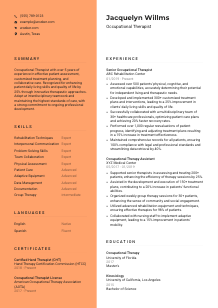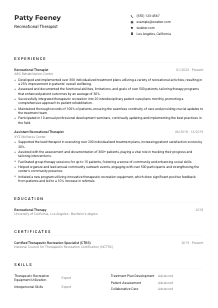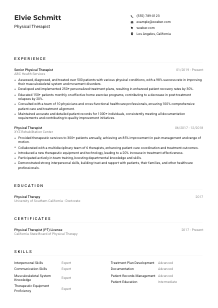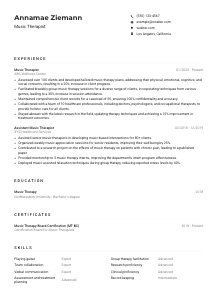Occupational Therapist Resume Example
Helping others rebound, but your resume feels off-balance? Swing into this Occupational Therapist resume example, tweaked with Wozber free resume builder. Learn how to harmonize your patient-centered expertise with job expectations, creating a career profile that's as restorative as your therapy sessions!

How to write an Occupational Therapist Resume?
Embarking on your journey as an Occupational Therapist requires more than just skill and passion for helping others regain their independence. In today's competitive job landscape, your resume acts as a critical bridge, connecting your profound expertise to the right opportunities. Harness the power of Wozber's free resume builder to tailor a resume that aligns seamlessly with your dream role. This guide, rich in tips and examples generated using Wozber's ATS-friendly resume template and ATS resume scanner, is your first step towards crafting an ATS-compliant resume that stands out.
Ready to transform your professional narrative? Let's dive in!
Personal Details
Your personal details are akin to the introduction in a book – they set the stage for the story to come. For an Occupational Therapist, making this section resonate with your professionalism and readiness is crucial.
1. Present Your Name Prominently
Think of your name as the title of your professional narrative. Ensure it's clearly visible, employing a legible font that asserts your presence.
2. Job Title Alignment
Aligning your job title directly with the role you're applying for, such as 'Occupational Therapist,' immediately connects your resume to the job at hand, acting like a homing signal for recruiters.
3. Essential Contact Details
List down your phone number and a professional email address formatted as firstname.lastname@email.com. These details should be accurate and easily noticeable, ensuring hiring managers can reach you without a hitch.
4. Geographical Relevance
Location is more than just a place; it's an assurance. Mentioning "Austin, Texas," as your base of operations or willingness to relocate there meets the employer's specified requirement head-on, simplifying their selection process.
5. Professional Online Presence
Include a link to your LinkedIn profile or professional website. Ensure it's reflective of your resume, showcasing your dedication and readiness to engage in professional networks.
Takeaway
Your personal details are more than just words on a page; they're the foundation of your professional story. Make them count by ensuring they're clear, concise, and aligned with what the Occupational Therapist role seeks. Remember, first impressions matter.





Experience
The Experience section of your resume is where you can truly shine. For an Occupational Therapist, translating your hands-on experience into compelling narratives can set you apart.
- Assessed over 500 patients' physical, cognitive, and emotional capabilities, accurately determining their potential for independent living and therapeutic needs.
- Developed and implemented 300+ customized treatment plans and interventions, leading to a 25% improvement in clients' daily living skills and quality of life.
- Successfully collaborated with a multidisciplinary team of 30+ healthcare professionals, optimizing patient care plans and achieving 20% faster recovery rates.
- Performed over 1,000 regular reevaluations of patient progress, identifying and adjusting treatment plans resulting in a 15% increase in treatment effectiveness.
- Maintained comprehensive records for all patients, ensuring 100% compliance with legal and professional standards and streamlining data retrieval by 40%.
- Supported senior therapists in assessing and treating 200+ patients, enhancing the efficiency of therapy sessions by 25%.
- Assisted in the development and execution of 150+ treatment plans, contributing to a 20% increase in patients' functional abilities.
- Organized weekly group therapy sessions for 30+ patients, enhancing the sense of community and social engagement.
- Utilized advanced rehabilitation equipment and techniques, ensuring effective therapies for 98% of patients.
- Collaborated with nursing staff to implement adaptive equipment, leading to a 15% improvement in patients' mobility.
1. Dissect the Job Requirements
Begin with a deep dive into the job requirements, identifying key phrases like 'assess patients' physical, cognitive, and emotional capabilities' and 'collaborate with multidisciplinary teams.' These are goldmines for aligning your experience.
2. Structured Professional Journey
Organize your experience chronologically, emphasizing roles that bring out your expertise as an Occupational Therapist. Place the most recent and relevant positions at the forefront, demonstrating a trajectory of growth and specialization.
3. Crafting Achievement Statements
For each role, articulate your accomplishments, especially those that resonate with the job description. Statements like 'Developed and implemented 300+ customized treatment plans, leading to a 25% improvement in clients' daily living skills and quality of life' directly address the responsibilities and requisite skills of the position.
4. Quantification of Achievements
Quantifying your impact not only provides tangible proof of your competencies but also gives recruiters a clear measure of your effectiveness. Whenever possible, include statistics and outcomes to elevate your experience.
5. Relevance is Key
While all experiences shape us, focus on those that mirror the demands of being an Occupational Therapist. Tailor your resume to reflect only the most pertinent achievements, showcasing your readiness for the role.
Takeaway
Weaving your experiences into a narrative that speaks directly to the Occupational Therapist role positions you as the ideal candidate. Use this section to tell your unique story, highlighting the journey that's led you here. With each bullet point, affirm your capability and fit for the job.
Education
In the world of Occupational Therapy, your educational background is not just a testament to your knowledge; it's a beacon of your dedication to the profession.
1. Highlight Key Degrees
Directly align your degree(s) with the job requirement. For instance, listing a 'Master's in Occupational Therapy' showcases not just your educational achievement but your specific qualification for the role.
2. Simple Yet Informative Structure
Structure your education section to include the degree obtained, the field of study, and the institution's name, followed by the graduation date. This clear format ensures easy readability and instant connection with the job requirements.
3. Degree Specificity
If the role explicitly requires a 'Bachelor's or Master's degree in Occupational Therapy,' make sure your education reflects this requirement precisely. Tailoring this section to mirror the job description signifies clear qualifications.
4. Relevant Courses and Achievements
While your degree speaks volumes, highlighting relevant coursework, honors, or awards can add depth to your educational background, further establishing your commitment and expertise in the field of Occupational Therapy.
5. Consider Other Academic Indicators
For those at the dawn of their Occupational Therapy career, or if your degree is closely aligned with the role, spotlighting significant projects or thesis work relevant to Occupational Therapy can provide a more comprehensive view of your capabilities.
Takeaway
Your education section is a testament to your dedication and preparation for the Occupational Therapist role. By aligning this part of your resume with the job requirements, you not only demonstrate your qualifications but also your commitment to excellence in your field.
Certificates
In the realm of Occupational Therapy, certifications can serve as the linchpin in validating your expertise and commitment to continuous learning.
1. Match with Job Requirements
Although the job description might not specify certifications, listing relevant credentials, such as an 'Occupational Therapist License' or 'Certified Hand Therapist (CHT),' instantly bolsters your qualifications and showcases your specialized skills.
2. Selective Highlighting
Prioritize certifications that align directly with the position. This targeted approach ensures your resume resonates with the specific demands of an Occupational Therapist, demonstrating your thorough preparation for the role.
3. Transparency and Currency
Be upfront about the validity period of your certifications. Maintaining up-to-date credentials not only showcases your current capabilities but also illustrates your dedication to adhering to the latest standards in the field.
4. Continuous Professional Development
Emphasize your commitment to professional growth by continually seeking out new certifications and learning opportunities, especially those that enhance your role as an Occupational Therapist. This proactive approach speaks volumes about your dedication to excellence.
Takeaway
Highlighting pertinent certifications conveys a message of professionalism and expertise. These credentials serve as proof of your commitment to maintaining the highest standards in Occupational Therapy, setting you apart in the hiring process.
Skills
The Skills section of your resume offers a succinct snapshot of your capabilities. For an Occupational Therapist, presenting a blend of technical proficiency and interpersonal finesse is paramount.
1. Dissecting the Job Description
Start by identifying both hard and soft skills mentioned in the job posting. Skills like 'Rehabilitation Techniques' and 'Interpersonal Communication' are direct matches, providing a clear pathway to tailoring your resume.
2. Prioritize Pertinent Skills
Highlight skills that align closely with the Occupational Therapist role, ensuring each skill listed bolsters your candidacy. This focus allows hiring managers to quickly ascertain your suitability for the role.
3. Organization and Clarity
A neat and focused listing of skills invites attention. Prioritize skills that showcase your expertise as an Occupational Therapist, weaving together a comprehensive picture of your professional toolkit.
Takeaway
Curating your skills with precision and purpose reveals the essence of your professional identity. Make this section a compelling exhibition of your capabilities, ensuring it reflects the acumen and compassion fundamental to an Occupational Therapist.
Languages
For an Occupational Therapist, the ability to communicate effectively is paramount, not only in English but possibly in other languages too, depending on your patient demographic.
1. Analyzing Language Requirements
While the job specifies 'English fluency,' expanding on your linguistic abilities can illustrate a readiness to engage with diverse patient populations.
2. Emphasize Necessary Languages
List English at the top, denoting your proficiency level as 'Native' or 'Fluent,' to meet the job's critical requirement head-on.
3. Additional Languages
Any additional languages should follow, with an honest assessment of your proficiency. This breadth of linguistic capability showcases your adaptability and eagerness to cater to a diverse client base.
4. Accurate Proficiency Levels
Being upfront about your language proficiency levels—from 'Basic' to 'Fluent'—ensures clear communication expectations, fostering trust right from the get-go.
5. Understanding the Role's Scope
Consider the broader scope of your role and the communities you may serve. Additional languages can significantly enhance your resume, marking you as a versatile and empathetic Occupational Therapist.
Takeaway
Your linguistic skills are more than just a section on your resume; they're a testament to your ability to connect and communicate. Highlighting your language proficiency portrays you as an Occupational Therapist equipped to provide nuanced, compassionate care to a diverse patient population.
Summary
Your resume summary is the concise narrative that encapsulates your professional identity. For Occupational Therapists, it's an opportunity to highlight your unique blend of skills, experience, and passion.
1. Grasping the Job's Core
Begin by internalizing the essence of the job description, identifying key skills and responsibilities that you can echo in your summary.
2. A Strong Opening
Introduce yourself as an Occupational Therapist, emphasizing your years of experience and areas of expertise. This opening statement sets the tone for the narrative that follows.
3. Highlighting Key Qualifications
Showcase your alignment with the job's needs by detailing your most relevant skills and notable accomplishments. For instance, a statement like, 'Recognized for enhancing patient daily living skills and quality of life through innovative therapy approaches' directly speaks to the job requirements.
4. Brevity is Brilliance
Keep your summary focused and impactful. Aim for 3-5 lines that introduce you, emphasize your fit for the role, and invite the reader to delve deeper into your resume.
Takeaway
Think of your summary as a professional handshake. It's your chance to make a positive, compelling first impression. Tailor it with precision to reflect both your identity as an Occupational Therapist and your enthusiasm for the opportunity ahead. Let it serve as a powerful preamble to your detailed qualifications.
Launching Your Occupational Therapist Journey
Armed with a meticulously crafted resume, you're now ready to step into the world with confidence and clarity. Wozber's free resume builder, featuring ATS-friendly resume templates and an intuitive ATS resume scanner, is designed to help you craft a resume that not only meets the mark but exceeds expectations. Let your journey as an Occupational Therapist be guided by insight, preparation, and a resume that truly represents your dedication to enriching lives. Here's to your next chapter; may it be as fulfilling as the care you provide.

- Bachelor's or Master's degree in Occupational Therapy from an accredited program.
- Valid state licensure as an Occupational Therapist, or the ability to obtain within a specified timeframe.
- Minimum of 2 years of clinical experience in a relevant setting.
- Strong knowledge of rehabilitation methods and techniques, as well as best practices in patient care.
- Exceptional interpersonal, communication, and problem-solving skills.
- English fluency is a critical requirement.
- Must be located in or willing to relocate to Austin, Texas.
- Assess patients' physical, cognitive, and emotional capabilities to determine potential for independent living and therapeutic needs.
- Develop customized treatment plans and interventions to improve clients' daily living skills and quality of life.
- Collaborate with multidisciplinary teams, including physicians and other healthcare professionals, to plan and evaluate patient care.
- Perform regular reevaluations of patient progress, adjusting treatment plans as necessary.
- Maintain thorough and accurate patient records, ensuring compliance with legal and professional standards.















